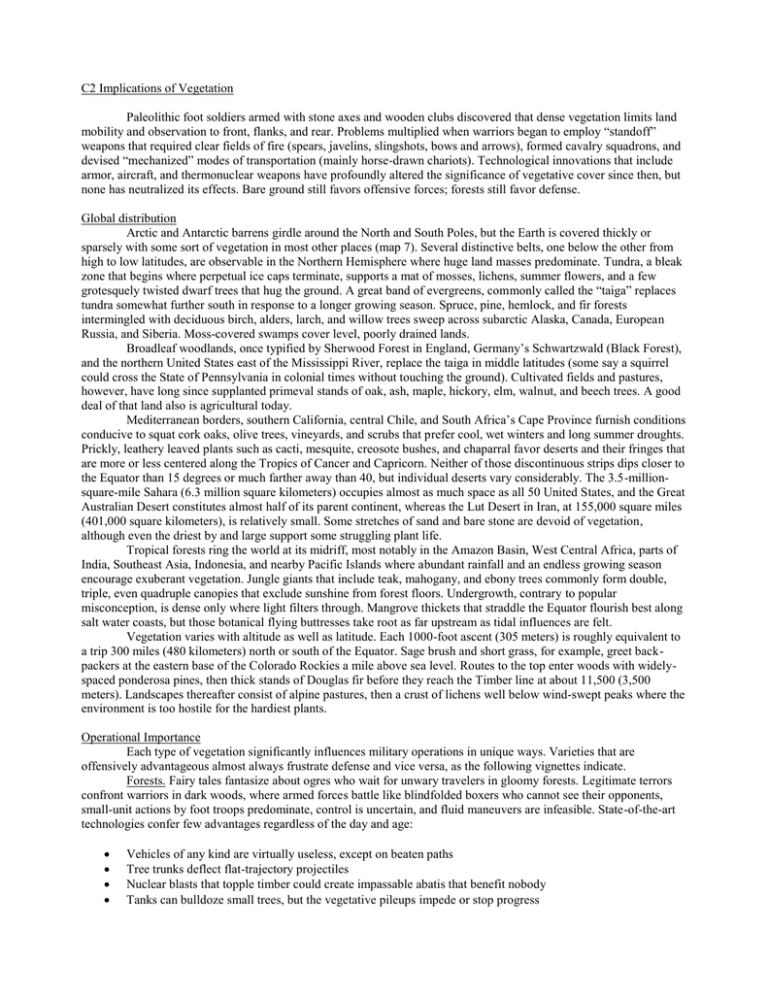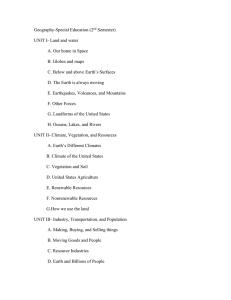C2 Implications of Vegetation
advertisement

C2 Implications of Vegetation Paleolithic foot soldiers armed with stone axes and wooden clubs discovered that dense vegetation limits land mobility and observation to front, flanks, and rear. Problems multiplied when warriors began to employ “standoff” weapons that required clear fields of fire (spears, javelins, slingshots, bows and arrows), formed cavalry squadrons, and devised “mechanized” modes of transportation (mainly horse-drawn chariots). Technological innovations that include armor, aircraft, and thermonuclear weapons have profoundly altered the significance of vegetative cover since then, but none has neutralized its effects. Bare ground still favors offensive forces; forests still favor defense. Global distribution Arctic and Antarctic barrens girdle around the North and South Poles, but the Earth is covered thickly or sparsely with some sort of vegetation in most other places (map 7). Several distinctive belts, one below the other from high to low latitudes, are observable in the Northern Hemisphere where huge land masses predominate. Tundra, a bleak zone that begins where perpetual ice caps terminate, supports a mat of mosses, lichens, summer flowers, and a few grotesquely twisted dwarf trees that hug the ground. A great band of evergreens, commonly called the “taiga” replaces tundra somewhat further south in response to a longer growing season. Spruce, pine, hemlock, and fir forests intermingled with deciduous birch, alders, larch, and willow trees sweep across subarctic Alaska, Canada, European Russia, and Siberia. Moss-covered swamps cover level, poorly drained lands. Broadleaf woodlands, once typified by Sherwood Forest in England, Germany’s Schwartzwald (Black Forest), and the northern United States east of the Mississippi River, replace the taiga in middle latitudes (some say a squirrel could cross the State of Pennsylvania in colonial times without touching the ground). Cultivated fields and pastures, however, have long since supplanted primeval stands of oak, ash, maple, hickory, elm, walnut, and beech trees. A good deal of that land also is agricultural today. Mediterranean borders, southern California, central Chile, and South Africa’s Cape Province furnish conditions conducive to squat cork oaks, olive trees, vineyards, and scrubs that prefer cool, wet winters and long summer droughts. Prickly, leathery leaved plants such as cacti, mesquite, creosote bushes, and chaparral favor deserts and their fringes that are more or less centered along the Tropics of Cancer and Capricorn. Neither of those discontinuous strips dips closer to the Equator than 15 degrees or much farther away than 40, but individual deserts vary considerably. The 3.5-millionsquare-mile Sahara (6.3 million square kilometers) occupies almost as much space as all 50 United States, and the Great Australian Desert constitutes almost half of its parent continent, whereas the Lut Desert in Iran, at 155,000 square miles (401,000 square kilometers), is relatively small. Some stretches of sand and bare stone are devoid of vegetation, although even the driest by and large support some struggling plant life. Tropical forests ring the world at its midriff, most notably in the Amazon Basin, West Central Africa, parts of India, Southeast Asia, Indonesia, and nearby Pacific Islands where abundant rainfall and an endless growing season encourage exuberant vegetation. Jungle giants that include teak, mahogany, and ebony trees commonly form double, triple, even quadruple canopies that exclude sunshine from forest floors. Undergrowth, contrary to popular misconception, is dense only where light filters through. Mangrove thickets that straddle the Equator flourish best along salt water coasts, but those botanical flying buttresses take root as far upstream as tidal influences are felt. Vegetation varies with altitude as well as latitude. Each 1000-foot ascent (305 meters) is roughly equivalent to a trip 300 miles (480 kilometers) north or south of the Equator. Sage brush and short grass, for example, greet backpackers at the eastern base of the Colorado Rockies a mile above sea level. Routes to the top enter woods with widelyspaced ponderosa pines, then thick stands of Douglas fir before they reach the Timber line at about 11,500 (3,500 meters). Landscapes thereafter consist of alpine pastures, then a crust of lichens well below wind-swept peaks where the environment is too hostile for the hardiest plants. Operational Importance Each type of vegetation significantly influences military operations in unique ways. Varieties that are offensively advantageous almost always frustrate defense and vice versa, as the following vignettes indicate. Forests. Fairy tales fantasize about ogres who wait for unwary travelers in gloomy forests. Legitimate terrors confront warriors in dark woods, where armed forces battle like blindfolded boxers who cannot see their opponents, small-unit actions by foot troops predominate, control is uncertain, and fluid maneuvers are infeasible. State-of-the-art technologies confer few advantages regardless of the day and age: Vehicles of any kind are virtually useless, except on beaten paths Tree trunks deflect flat-trajectory projectiles Nuclear blasts that topple timber could create impassable abatis that benefit nobody Tanks can bulldoze small trees, but the vegetative pileups impede or stop progress The lethal radius of conventional bombs and artillery shells is much less then in open terrain, although the “bonus” effect of flying wood splinters can be considerable Hand grenades bounce aimlessly unless rolled at short ranges that sometimes endanger the senders Napalm burns out rapidly in moist greenery; flares illuminate very little; and dense foliage deadens radio communications Winners and losers are hard to predict when combat takes place in forests. Publius Quintilis Varus lost three wellarmed, well-trained Roman legions when beset by Teutonic barbarians near what now is Munster during the battle of Teutoburgerwald in 9 A.D. He and his senior henchmen committed suicide to avoid capture after that defeat, while survivors were crucified, buried alive, or sacrificed to pagan gods. Caesar Augustus shaped the political outline of Europe in many respects when, as a result, he abandoned plans to colonize lands that have become Germany. Forest campaigns ever since have often been costly to belligerents on both sides. Wilderness (U.S. Civil War, May 1864), Belleau Wood and Argonne Forest (World War I), Guadalcanal, Burma, and New Guinea (World War II), Vietnam, and Laos typify a few among many unhappy experiences that involved the United States. Scantily Clad Landscapes. Brush, high grass, tall crops typified by sorghum and corn (maize), orchards, and widely spaced plantation trees do little to limit aerial or spaceborne sensors and weapon systems. Such vegetation hinders vehicular movement very little, but it slows foot soldiers, reduces their visibility, and restricts fields of fire for land-based line-of-sight weapons. Wire-guided missiles that require clear ground between gunners and targets are useless in thickets and other entanglements. Dense herbage deflects thermal radiation caused by nuclear blasts, yet amplifies the persistence of chemical warfare agents. Immense steppes sparingly carpeted with short grass and deserts devoid of vegetation afford little cover or concealment for armed forces or military installations, but favor long-range observations and clear fields of fire. Air superiority and technological prowess count a lot under those conditions, as Iraq’s President Sadam Hussein discovered during Operation Desert Storm (1991), which took place on the geographic equivalent of a sand-covered pool table. His army, which was tactically and technologically deficient, lacked an air umbrella. Allied forces, aided by satellite intelligence, thus were able to bombard and maneuver at will while Iraqi formations risked destruction whether they moved or stayed still. One U. S. Marine Corps pilot quipped, “It was like being in the Super Bowl, but the other team didn’t show up.” Military Modifications. Military men have long sought to modify vegetative cover whenever it interferes with observation, fire lanes, cross-country trafficability, or affords adversaries convenient ambush sites. The best crossing sites unfortunately are apt to be staunchly defended and actual conditions seldom are ideal. German panzer divisions in Russia during World War II, for example, frequently found that marshy lowlands abutted both banks of large streams, floods loaded with sediment clogged inboard engines, ice floes each spring bombarded expedient bridges, and vehicles became toboggans on moderate slopes after torrential summer rains. Skilled tacticians nevertheless overcame such adversities and learned that landings at unexpected spots improve prospects for low-cost success. Land clearing. Bulldozers, which are used for most large-scale land clearing operations, can upend small trees and stumps up to 6 inches in diameter (15 centimeters), tree dozers (commonly called “Rome plows”) shear off somewhat larger trunks at ground level, leaving chain saws to fell timber of almost unlimited diameters and cut forest giants into manageable segments. Tractor-mounted units pull stumps; rippers reduce root systems; and grades windrow debris for disposal. Carefully controlled brush fires sometimes assist. Explosives occasionally may prove indispensable, but it takes time and energy to fill resultant craters. U.S. Army engineers in Vietnam used 30 bulldozers and Rome plows per team to remove dense vegetation around base camp perimeters, enemy infiltration routes, and potential ambush sites. Each team could create a helicopter landing zone in a matter of minutes or clear 150 to 250 forested acres a day on reasonably level terrain, although rough ground and thick secondary growth reduced output by half. Amphibious tree crushers, which weighed in at 97 tons, could churn through bogs and hack out wide swaths on dry land at a steady 3 miles (4 kilometers) an hour, but welders and radiator repairmen had to work around-the-clock on all vehicles to patch up punctured cooling systems and replace hydraulic lines that heavy brush ripped off. Defoliation. The U.S. Air Force, with permission from the Republic of Vietnam, began to spray chemical defoliants over the Cau Mau Peninsula in the Mekong Delta during 1962. That practice spread to the Rung Sat Special Zone, a mangrove swamp along shipping channels into Saigon, then countrywide, including the southern half of the demilitarized zone. Herbicides thus deposited produced desired results, but accompanying ecological and health problems sparked controversies that remained unresolved decades after the last load was released. Source: Collins, J. M. (1998). Military geography for professionals and the public. Washington DC: National Defense University.


